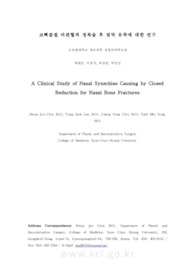

PARTNER
검증된 파트너 제휴사 자료
코뼈골절 비관혈적 정복술 후 점막유착에 대한 연구 (A Clinical Study of Nasal Synechiae Causing by Closed Reduction for Nasal Bone Fractures)
6 페이지
최초등록일 2025.05.17
최종저작일
2009.03

-
미리보기
서지정보
· 발행기관 : 대한성형외과학회
· 수록지 정보 : Archives of Plastic Surgery / 36권 / 2호 / 188 ~ 193페이지
· 저자명 : 최환준, 탁민성, 이용석, 최창용
초록
Purpose: Several authors reported about the post- traumatic nasal aesthetic complications. However, the studies for functional or intra-nasal complications have been rarely reported. The aim of this study is to observe the incidence of intranasal synechia.
Methods: We reviewed the data from 401 consecutive patients with nasal bone fracture from september 2006 to December 2007. We enforced evaluation with preoperative CT in all patients but postoperative CT within complicated patients. We classified the nasal bone fracture according to the anatomy and severity of fracture. Type I is nasal tip fracture(15%, n=59), Type II is simple lateral without septal injury(38%, n=152), Type III is simple lateral with septal injury(23%, n=92), Type IV is closed comminuted(20%, n=82), Type V is open comminuted or complicated(4%, n=16). We studied 98 patients with nasal bone fracture who had postoperative symptoms or underwent postoperative endoscopic evaluation. And then we evaluated the postoperative endoscopic finding and nasal synechal formation after operation.
Results: The incidence of intranasal synechiae was 15%(n=62). According to the endoscopic findings, the incidence of intranasal synechiae was 10%(n=6) in Type I, 8%(n=12) in Type II, 16%(n=15) in Type III, 24%(n= 20) in Type IV, and 56%(n=9) in Type V, respectively. Additionally, the incidence of subjective nasal obstruction and olfactory dysfunction is 18%(n=72) and 13%(n= 51), while the incidence of symptomatic synechiae of nasal obstruction and olfactory dysfunction is 92%(57/ 62) and 55%(34/62).
Conclusion: We identified relatively high prevalence of nasal obstruction and olfactory dysfunction in nasal synechiae. Based on the results of this study, intranasal synechiae really caused airway obstruction(92%). Our data showed significant relationship between intranasal synechiae and severity of the fracture, because of increasing mucosal handling and destructive closed reductional procedures. First of all, education of delicate procedure regarding this subject should be empathized accordingly.영어초록
Purpose: Several authors reported about the post- traumatic nasal aesthetic complications. However, the studies for functional or intra-nasal complications have been rarely reported. The aim of this study is to observe the incidence of intranasal synechia.
Methods: We reviewed the data from 401 consecutive patients with nasal bone fracture from september 2006 to December 2007. We enforced evaluation with preoperative CT in all patients but postoperative CT within complicated patients. We classified the nasal bone fracture according to the anatomy and severity of fracture. Type I is nasal tip fracture(15%, n=59), Type II is simple lateral without septal injury(38%, n=152), Type III is simple lateral with septal injury(23%, n=92), Type IV is closed comminuted(20%, n=82), Type V is open comminuted or complicated(4%, n=16). We studied 98 patients with nasal bone fracture who had postoperative symptoms or underwent postoperative endoscopic evaluation. And then we evaluated the postoperative endoscopic finding and nasal synechal formation after operation.
Results: The incidence of intranasal synechiae was 15%(n=62). According to the endoscopic findings, the incidence of intranasal synechiae was 10%(n=6) in Type I, 8%(n=12) in Type II, 16%(n=15) in Type III, 24%(n= 20) in Type IV, and 56%(n=9) in Type V, respectively. Additionally, the incidence of subjective nasal obstruction and olfactory dysfunction is 18%(n=72) and 13%(n= 51), while the incidence of symptomatic synechiae of nasal obstruction and olfactory dysfunction is 92%(57/ 62) and 55%(34/62).
Conclusion: We identified relatively high prevalence of nasal obstruction and olfactory dysfunction in nasal synechiae. Based on the results of this study, intranasal synechiae really caused airway obstruction(92%). Our data showed significant relationship between intranasal synechiae and severity of the fracture, because of increasing mucosal handling and destructive closed reductional procedures. First of all, education of delicate procedure regarding this subject should be empathized accordingly.참고자료
· 없음태그
-
자주묻는질문의 답변을 확인해 주세요

꼭 알아주세요
-
자료의 정보 및 내용의 진실성에 대하여 해피캠퍼스는 보증하지 않으며, 해당 정보 및 게시물 저작권과 기타 법적 책임은 자료 등록자에게 있습니다.
자료 및 게시물 내용의 불법적 이용, 무단 전재∙배포는 금지되어 있습니다.
저작권침해, 명예훼손 등 분쟁 요소 발견 시 고객센터의 저작권침해 신고센터를 이용해 주시기 바랍니다. -
해피캠퍼스는 구매자와 판매자 모두가 만족하는 서비스가 되도록 노력하고 있으며, 아래의 4가지 자료환불 조건을 꼭 확인해주시기 바랍니다.
파일오류 중복자료 저작권 없음 설명과 실제 내용 불일치 파일의 다운로드가 제대로 되지 않거나 파일형식에 맞는 프로그램으로 정상 작동하지 않는 경우 다른 자료와 70% 이상 내용이 일치하는 경우 (중복임을 확인할 수 있는 근거 필요함) 인터넷의 다른 사이트, 연구기관, 학교, 서적 등의 자료를 도용한 경우 자료의 설명과 실제 자료의 내용이 일치하지 않는 경우
“Archives of Plastic Surgery”의 다른 논문도 확인해 보세요!
-
Mulliken 방법을 이용한 일측성 구순열의 장기 추적결과 9 페이지
Purpose: The Mulliken’s method is a one of the very excellent technique to correction of the unilateral cleft lip. It could decrease the need of additional operation and second operation by the early .. -
고주파절제술을 통한 선택적 신경차단법을 이용한 미간주름의 개선 6 페이지
Purpose: Corrugator supercilii muscle pulls eyebrow to inferomedial direction and produces the vertical component of the glabellar line formation. Current techniques for eliminating of glabellar frown.. -
전외측 대퇴부 유리피판술 이용한 제1수지간 반흔구축 재건 6 페이지
Purpose: First web space contracture of the hand has been treated with various surgical techniques such as Z-plasty, local flap, pedicled flap, distant free flap, and anterolateral thigh free flap. Am.. -
심하복벽동맥 천공지 유리피판에서 술전 MDCT의 유용성 7 페이지
Purpose: Autologous breast reconstruction with abdominal tissue is one of the best options after mastectomy. In a free transverse rectus abdominis myocutaneous(TRAM) or deep inferior epigastric artery.. -
실리콘 관을 이용한 이층 정관정관 문합술 5 페이지
Purpose: Because of the volume of elective sterilizations performed in the world during the past decade, the vasectomy was a popular method for male sterilization in Korea and this, in turn, had been ..
문서 초안을 생성해주는 EasyAI
